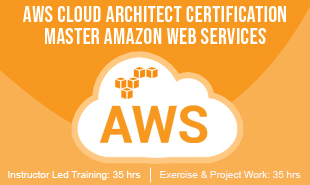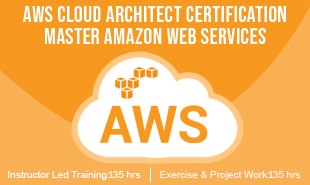

Overview
Course Description
AWS certification includes the latest changes in SAA-C02 as well as covers the concepts of SAA-C01. It will make you master skills such as AWS cloud, IAM, Lambda, Redshift, EC2, S3, CloudTrail, Global Accelerator, FSx, and more. You will work with various tools of the AWS cloud platform and create highly scalable, highly available, and fault-tolerant SaaS applications. Learn from top-rated AWS-certified mentors to become an AWS Certified Solutions Architect.
Course Content
Module 01 - Introduction to Cloud Computing & AWS
1.1 What is Cloud Computing
1.2 Cloud Service & Deployment Models
1.3 How AWS is the leader in the cloud domain
1.4 Various cloud computing products offered by AWS
1.5 Introduction to AWS S3, EC2, VPC, EBS, ELB, AMI
1.6 AWS architecture and the AWS Management Console, virtualization in AWS (Xen hypervisor)
1.7 What is auto-scaling
1.8 AWS EC2 best practices and cost involved.
Module 02 - Elastic Compute and Storage Volumes
2.1 Introduction to EC2
2.2 Regions & Availability Zones(AZs)
2.3 Pre-EC2, EC2 instance types
2.4 Comparing Public IP and Elastic IP
2.5 Demonstrating how to launch an AWS EC2 instance
2.6 Introduction to AMIs, Creating and Copying an AMI
2.7 Introduction to EBS
2.8 EBS volume types
2.9 EBS Snapshots
2.10 Introduction to EFS
2.11 Instance tenancy- Reserved and Spot instances
2.12 Pricing and Design Patterns.
Module 03 - Load Balancing, Autoscaling and DNS
3.1 Introduction to Elastic Load Balancer
3.2 Types of ELB – Classic, Network and Application
3.3 Load balancer architecture
3.4 Cross-zone load balancing
3.5 Introduction to Auto Scaling, vertical and horizontal scaling, the lifecycle of Auto Scaling
3.6 Components of Auto Scaling, scaling options and policy, instance termination
3.7 Using load balancer with Auto Scaling
3.8 Pre-Route 53 – how DNS works
3.9 Routing policy, Route 53 terminologies, Pricing
Module 04 - Virtual Private Cloud
4.1 What is Amazon VPC,
4.2 VPC as a networking layer for EC2,
4.3 IP address and CIDR notations,
4.4 Components of VPC – network interfaces, route tables, internet gateway, NAT,
4.5 Security in VPC – security groups and NACL, types of VPC, what is a subnet, VPC peering with scenarios, VPC endpoints, VPC pricing and design patterns.
Module 05 - Storage - Simple Storage Service (S3)
5.1 Introduction to AWS storage
5.2 Pre-S3 – online cloud storage
5.3 API, S3 consistency models
5.4 Storage hierarchy, buckets in S3
5.5 Objects in S3, metadata and storage classes, object versioning, object lifecycle management, cross-region replication, data encryption, connecting using VPC endpoint, S3 pricing
Module 06 - Databases and In-Memory DataStores
6.1 What is a database, types of databases, databases on AWS
6.2 Introduction to Amazon RDS
6.3 Multi-AZ deployments, features of RDS
6.4 Read replicas in RDS, reserved DB instances
6.5 RDS pricing and design patterns
6.6 Introduction to Amazon Aurora, benefits of Aurora, Aurora pricing and design patterns
6.7 Introduction to DynamoDB, components of DynamoDB, DynamoDB pricing and design patterns
6.8 What is Amazon Redshift, advantages of Redshift
6.9 What is ElastiCache, why ElastiCache
Module 07 - Management and Application Services
7.1 Introduction to CloudFormation
7.2 CloudFormation components
7.3 CloudFormation templates
7.4 The concept of Infrastructure-as-a-code
7.5 Functions and pseudo parameters
7.6 Introduction to Simple Notification Service, how does SNS work
7.7 Introduction to Simple Email Service, how does SES work
7.8 Introduction to Simple Queue Service, how does SQS work.
Module 08 - Access Management and Monitoring Services
8.1 Pre-IAM, why access management
8.2 Amazon Resource Name (ARN), IAM features
8.3 Multi-factor authentication (MFA) in IAM, JSON
8.4 IAM policies, IAM permissions, IAM roles, identity federation, pricing
8.5 Introduction to CloudWatch, metrics and namespaces, CloudWatch architecture, dashboards in CW, CloudWatch alarms, CloudWatch logs, pricing and design patterns
8.6 Introduction to CloudTrail, tracking API usage.
Module 09 - Automation and Configuration management
9.1 What is AWS Lambda
9.2 How Lambda is different from EC2
9.3 Benefits and limitations of Lambda
9.4 How does Lambda work
9.5 Use cases of Lambda, Lambda concepts
9.6 Integration S3 with Lambda
9.7 What is Elastic Beanstalk, how does Beanstalk work, Beanstalk concepts, Beanstalk pricing
9.8 What is configuration management
9.9 What is AWS OpsWorks, AWS OpsWorks benefits
9.10 CloudFormation vs OpsWorks, services in OpsWorks, AWS OpsWorks Stacks, OpsWorks pricing
Module 10 - AWS Migration
10.1 What is Cloud migration
10.2 Why migration is important
10.3 Migration process in AWS, the 6 R’s migration strategy
10.4 Virtual machine migration, migrating a local vm onto the AWS cloud
10.5 Migrating databases using Database Migration Service (DMS)
10.6 Migrating a local database to RDS
10.7 Migrating an on-premises database server to RDS using DMS, other migration services.
Student feedback
0 Reviews
- 0
- 0
- 0
- 0
- 0
0.0
out of 5
Course Rating
Related Courses

Add Reviews & Rate